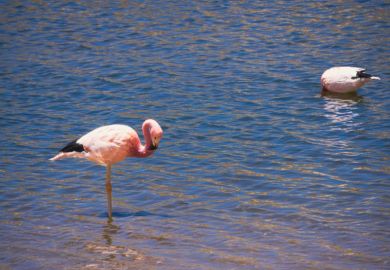In J. R. R. Tolkien’s epic narrative The Lord of the Rings, a diverse fellowship of humans, hobbits, an elf, a dwarf and a wandering wizard must overcome their differences to confront a threat to their shared existence. Only by working together can they destroy the source of individual authority and domination – the ring of power – and defeat the armies of darkness.
The real Middle Earth of our ancestral human past was home to a range of distinct hominins not unlike the characters in Tolkien’s tale, a work whose central theme is that group cooperation was responsible for the birth of human civilisation. In The Gap: The Science of What Separates Us From Other Animals, Thomas Suddendorf builds on 20 years of work in psychology and human evolution to argue for a unifying framework to explain the ascent of man. As it turns out, the two qualities that bridge the gap between ourselves and our nearest living relatives are also those that Tolkien utilised in creating his fictional world: a capacity for imaginative storytelling and a unique ability to integrate ideas and actions collaboratively.
According to Suddendorf, the human capability to imagine abstract ideas – which he calls nested scenario building – combined with our urge to connect with others and transformed animal communication into human language, habitual behaviour into cultural traditions, problem-solving into abstract reasoning, and empathy into morality. In considering this last transformation, Suddendorf closely follows the theory that Darwin first put forward in The Descent of Man, that empathy extended outwards from the in-group in an ever-expanding circle of concern as distinct populations competed and integrated. Influenced by gossip and the desire for the approbation of peers, individuals adjusted their behaviour to fit the moral norms of their society. In this way, the abstract concept of human equality grew from a norm followed only within the boundaries of a particular tribal community to its enshrinement in the Universal Declaration of Human Rights.
However, Suddendorf notes that while humans – from hunter-gatherers to members of industrial societies – have a tendency to act for the greater good, the human ability to “network” abstract thinking and behaviour also has its dark side. Because our moral sense evolved to benefit members of the in-group, our capacity to demonise an external “other” has led to calamities from genocide and militarism to racism and xenophobia that remain a challenge as we seek to build an international moral community. Indeed, despite the diversity of Homo species that coexisted with early humans, including the Neanderthal, Denisovan and floresiensis (the so-called “hobbit” from the Indonesian island of Flores), just one species survives today. Some evidence, such as fossil skeletons with projectile injuries to their ribcages, suggests that humans may have been responsible for their extinction. The implication is that there could be a gap between humans and our nearest living relatives because we worked together to eliminate those who had once been closer. Sorry, Frodo.
While Suddendorf provides an excellent review of the existing literature to support his argument, at times his simplification of issues outside his area of expertise results in unfortunate distortions. For example, when discussing the Great Ape Project that seeks to grant personhood status for orang-utans, gorillas, chimpanzees and bonobos, he confuses the concept of non-human personhood rights with civil rights. The former involves the responsibility on the part of governments to protect such species, but does not entail responsibilities for the apes themselves. Therefore, when Suddendorf asks, “Would we be willing to put an ape on trial for murder?” as a rhetorical argument against the project, he merely reveals that he is uninformed about the specifics of this issue.
Minor quibbles aside, The Gap offers a compelling synthesis of the current literature on human evolution and comparative psychology to address the big questions of our species’ uniqueness. Fittingly, if the origin of human potential began with our ability for imaginative storytelling, Suddendorf’s narrative is an excellent addition to our species’ legacy. Even if we humans were responsible for the demise of our hominin sister-species, evidence is growing that Neanderthal, Denisovan and the floresiensis hobbits all interbred with our direct ancestors and left their mark in our DNA. In the end, at the genetic level, the fellowship continues.
The Gap: The Science of What Separates Us From Other Animals
By Thomas Suddendorf
Basic Books, 368pp, £19.99
ISBN 9780465030149 and 069842
Published 13 February 2014
Register to continue
Why register?
- Registration is free and only takes a moment
- Once registered, you can read 3 articles a month
- Sign up for our newsletter
Subscribe
Or subscribe for unlimited access to:
- Unlimited access to news, views, insights & reviews
- Digital editions
- Digital access to THE’s university and college rankings analysis
Already registered or a current subscriber?





